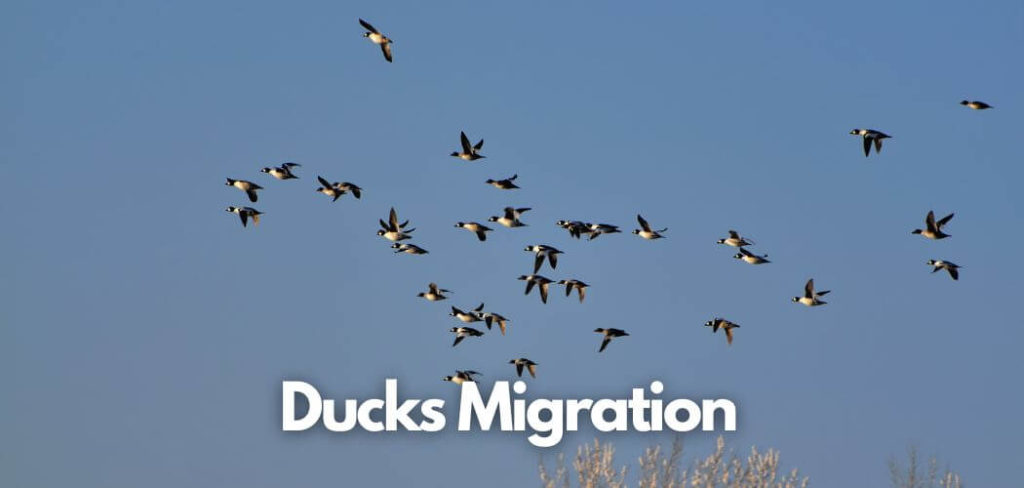Have you ever wondered why you don’t see ducks in a particular area all year round, is it that they go somewhere else or do they migrate?
Yes, ducks do migrate just like other popular bird does in search of better living conditions. we shall talk about duck migration, what time of the year they migrate, and how they migrate.

How do ducks migrate?
Ducks are migratory birds that travel long distances for food and better breeding grounds. The migration patterns of ducks vary depending on the species, but most ducks follow the same general route each year.
During migration, ducks fly in a V-formation, with one bird leading the way and the others following behind in a staggered pattern.
This formation helps reduce wind resistance and allows the ducks to conserve energy during their long journey. The lead duck will take turns with the other birds so that no one bird is always at the front.
Ducks have a keen sense of direction and can navigate using the sun, stars, and Earth’s magnetic field.
They also use landmarks like mountains and rivers to help them find their way. Some species of ducks, such as the mallard, can detect polarized light, which helps them orient themselves even on cloudy days.
During migration, ducks may fly for several hours without stopping. However, they do take breaks to rest and feed along the way.
Ducks will stop at lakes, rivers, and other bodies of water to rest and feed on aquatic plants and insects. They may also stop in fields to eat grains and seeds.
Why do ducks migrate?
Here are the main reasons why ducks just like most other birds will migrate to another part of the world

Whether condition:
Ducks migrate in response to seasonal changes. As the weather gets colder, the birds move to warmer areas in search of better living conditions.
In the spring, they return to their breeding grounds in the north. This migration is a natural behavior that has been observed in ducks for centuries.
Breeding habits:
Another reason for duck migration is breeding. Many species of ducks breed in the northern regions of the world during the summer months.
As the weather gets colder, they will move to warmer areas down south. This allows them to survive the winter and be ready to breed again in the spring.
Food availability:
Food availability is also a significant factor in duck migration. Ducks need a steady supply of food to survive, and they will move to areas where food is abundant.
This is why many ducks migrate to wetlands and other areas where there is a lot of food available. They will also move to areas where there is less competition for food.
How long does duck migration take?
Some species of ducks, such as the mallard, have been known to complete their entire migration in as little as two weeks.
Others, such as the eider duck, may take up to three months to reach their destination. Duck migration in general can take anywhere from a few weeks to several months depending on the distance they need to travel and the speed at which they fly.
The length of time it takes for ducks to migrate also depends on the weather conditions they encounter during their journey.
Strong headwinds and storms can slow them down, while favorable tailwinds can speed up their flight.
The speed at which ducks fly during migration can vary depending on the species of duck and environmental conditions.
On average, ducks typically fly at speeds ranging from 20 to 50 miles per hour (32 to 80 kilometers per hour) during migration. However, individual ducks or species may exceed or fall below this range.
Migration speeds can also be influenced by factors such as wind conditions, rain, and the distance to be covered.
It’s important to note that not all ducks migrate. Some species, such as the wood duck and the muscovy duck, are non-migratory and remain in their breeding grounds all year round.
List of ducks that migrate:
Mallard:
Mallards are one of the most common ducks in North America. They are known for their distinctive green head and white neck ring.
These ducks are found in wetlands, ponds, and rivers across the continent. Mallards are migratory birds that breed in the northern United States and Canada and winter in the southern United States and Mexico.
They travel in large flocks and can cover great distances during migration.
Northern pintail ducks:
Northern pintails are medium-sized ducks with long, pointed tails. They have a distinctive brown and white striped head and a slim, elegant body.
These ducks breed in the northern parts of North America, Europe, and Asia and winter in the southern United States, Mexico, and Central America.
Northern pintails are highly migratory and travel in large flocks along flyways across continents.
Green-winged teal:
Green-winged teals are small, compact ducks with a distinctive green patch on their wings.
They breed in the northern United States and Canada and winter in the southern United States, Mexico, and Central America.
These ducks are highly migratory and can travel long distances during migration. Green-winged teals are often seen in small flocks and are known for their fast, darting flight.
Are there ducks that don’t migrate?
While many species of ducks are known for their long migratory journeys, some do not migrate. These ducks are typically found in areas with mild climates and abundant food sources year-round.
One such species is the Muscovy duck, which is native to Mexico, Central, and South America.
Muscovy ducks are known for their adaptability and can thrive in both urban and rural environments. They are also able to fly short distances but prefer to walk or swim.
Another species of duck that does not migrate is the Australian wood duck.
These ducks are found throughout Australia and are known for their distinctive markings and preference for wooded areas near water sources.
They can breed year-round and do not need to migrate to find suitable breeding grounds.
In addition, some domesticated breeds of ducks, such as Pekin ducks, do not migrate. These ducks are commonly raised for meat and eggs and are often kept in captivity year-round.
Overall, while many species of ducks are known for their migratory habits, several species can thrive without the need for long-distance travel.
When do ducks migrate?
Ducks migrate twice a year, once in the fall and once in the spring. The fall migration usually begins in late August or early September and lasts until November.
During this time, ducks fly south to escape the cold winter weather and find better food sources. The spring migration, on the other hand, starts in late February or early March and lasts until May.
During this time, ducks fly back north to their breeding grounds.
The timing of migration can vary depending on the species of duck and their location. For example, ducks that breed in the Arctic tundra tend to migrate earlier than those that breed farther south.
Similarly, ducks that winter in the southern United States may migrate later than those that winter in Mexico or Central America.
Ducks also tend to migrate in flocks, which can range in size from a few individuals to thousands of birds.
They use a variety of clues to navigate during migration, including the position of the sun, stars, and Earth’s magnetic field.
When do ducks migrate back?
In North America, ducks usually begin their fall migration in September or October. They travel south to warmer climates where they can find food and water.
During the winter months, ducks will stay in their wintering grounds until it is time to migrate back north in the spring.
The timing of their spring migration can vary depending on the weather conditions.
Ducks will begin their journey back north once the ice starts to melt and the waterways begin to thaw. This usually occurs in March or April.
How many ducks migrate each year?
Each year, millions of ducks migrate across the globe in search of suitable breeding and feeding grounds.
The exact number of ducks that migrate each year is difficult to estimate, but it is believed that around half of the world’s duck population migrates annually.
According to the North American Waterfowl Management Plan, approximately 40 million ducks migrate to and from North America each year.
These ducks travel long distances, with some species flying up to 3,000 miles in a single journey.
Final thoughts:
Duck migration is a fascinating and complex phenomenon that is influenced by a range of environmental factors.
By understanding when ducks migrate and why, we can better appreciate these amazing birds and the challenges they face during their journeys.
